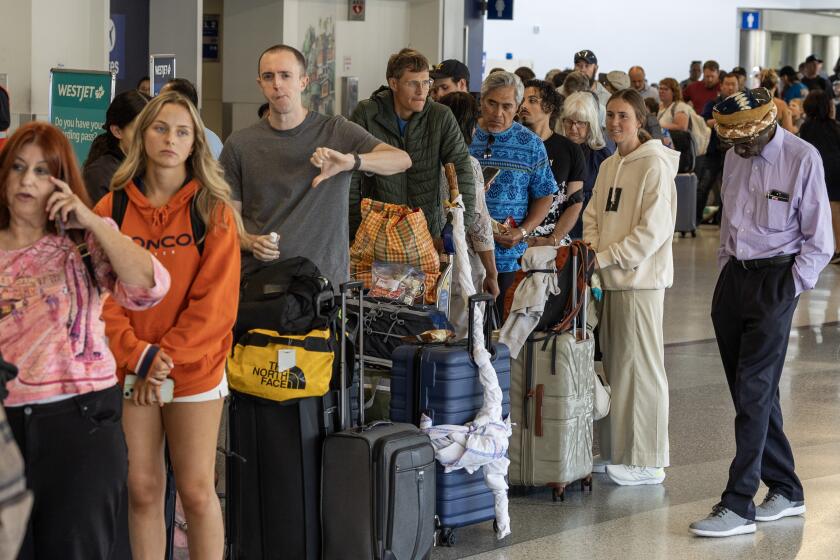The bizarre calculus of emergency room charges
Debbie Cassettari had outpatient foot surgery to remove a bone spur. She arrived at the surgery center at 8 a.m., left at 12:30 p.m., and the bill came to $37,000, not counting doctor fees. In recovery now from sticker shock, she’s waiting for her insurance company to do the tango with the clinic and figure out who owes what to whom.
Gary Larson has a $5,000 deductible insurance plan, but has found that his medical bills are cheaper if he claims he’s uninsured and pays cash. Using that strategy, an MRI scan of his shoulder cost him $350. His brother-in-law went to a nearby clinic for an MRI scan of his shoulder, was billed $13,000, and had to come up with $2,500.
Kaiser member Robert Merrilees had a colonoscopy at an affiliated surgery center, which charged $7,500. His co-pay was $15, Kaiser picked up $470, the rest of the bill “just went away.” Merrillees was left scratching his head over the crazy math in medical billing.
There is lots of head-scratching out there, and stories like these have poured in from across Southern California and beyond since I wrote last week about an 11-year-old girl and her $5,000 trip to an emergency room with a stomachache.
I heard from medical professionals who said fear of lawsuits leads to lots of play-it-safe tests and procedures. And some doctors and nurses argued that emergency rooms have to charge high prices because it’s extremely expensive to operate them 24 hours a day.
No doubt. But the larger point in last week’s column was that the calculus for medical charges in general is beyond comprehension, with outrageously high fees used as a starting point in a bizarre game of bargaining. Glenn Melnick, who teaches hospital finance at USC, told me it’s as crazy as if he asked to buy the TV in my living room, and I gave him a price of $1 million to start the conversation.
This is the kind of insanity that exists when medicine and medical insurance are about private profit rather than public health, when 50 million people are uninsured, when Medicare and Medicaid reimbursements don’t always cover true costs and when polarized politics prevent the kind of reasonable discussions that could lead to solutions.
In the case of Ella Moser, her grandfather — a physician and Yale professor who has written about medical overcharging —questioned the procedures that were done and the fees that were charged when she was treated in October at Providence Tarzana Medical Center. You can’t talk about rising healthcare costs and healthcare reform, he argued, without making both of those elements part of the discussion.
Ella’s father, John Moser, had a $5,000 deductible plan with Cigna, and had taken Ella to the hospital to rule out appendicitis. Nothing serious was diagnosed, and Ella went home to a quick recovery. Her dad got a bill for nearly $5,000 from the hospital, as well as bills for $540 from a pathologist and $309 from the doctor who treated her.
Like Moser, lots of patients are surprised to get separate bills like that, unaware that a hospital’s doctors can be independent contractors. It’s like going to a Laker game, paying $150 for a ticket, and later getting an additional $75 bill in the mail from Kobe Bryant.
Because of Moser’s deductible, Cigna paid no part of his bill. But the company’s contract with the hospital includes agreed-upon discounts, and those were passed on to Moser.
Just entering the emergency room had been billed at $1,288, for instance, but Moser paid Cigna’s negotiated rate of $682.64. The total charges, nearly $6,000, ended up costing him closer to $3,000.
But like his father, the doctor, Moser was left with lots of questions. How can you trust a business that bills you $1,288 but is happy to collect $682.64? Is the second number also arbitrary and perhaps artificially high? Hospitals argue that list prices are high to compensate for patients who don’t pay, but how can any patient on that spectrum know whether he’s getting a break or being ripped off?
A single-payer system would address some of this nonsense, but forget it. Even President Obama’s watered-down healthcare reform act, which may well die on the Supreme Court’s operating table, couldn’t be passed if it came up for a vote now.
Joseph Mondy, a Cigna spokesman, had some tips for anyone trying to avoid medical bankruptcy from an emergency room visit. Contact your health plan’s on-call nurse for advice on whether you need to visit an emergency room, consider a less expensive urgent care clinic if one is available, go to an in-network emergency room if possible and ask the doctor to explain why certain tests and procedures are necessary. Good advice I’m sure, but there’s not always time for all that in a genuine emergency.
Dr. Phil Schwarzman, medical director of the emergency department at Providence St. Joseph Medical Center, said 15 million of the nation’s uninsured people live in California, and he sees lots of them. From his front-line perspective, he finds it unconscionable that so many Americans have been driven into bankruptcy from medical costs, and he thinks mandated healthcare for everyone would restore some sanity to pricing.
And he speaks not just as a physician, but as a consumer.
Schwarzman has an insurance plan with a high deductible ($7,000). Like Gary Larson (the guy at the top of this column), Schwarzman also paid about $350 for a scan on himself that would have cost much more if he went with his insurance company’s negotiated rate. A couple of years ago, his daughter needed an ultrasound for a possible gallstone. If he’d gone through his insurance company, he would have been charged $3,200, with insurance paying $1,500, leaving him a $1,700 bill. He chose instead to leave insurance out of the equation and pay cash instead. The price was $250.
“It’s outrageous,” Schwarzman said. “I don’t know where they’re coming up with these numbers. Are they picking them out of a hat?”
steve.lopez@latimes.com
More to Read
Sign up for Essential California
The most important California stories and recommendations in your inbox every morning.
You may occasionally receive promotional content from the Los Angeles Times.







